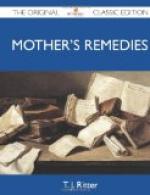If the bride decides to have but one attendant, the latter is usually styled her maid-of-honor, and may be her sister or her most intimate friend. If she has more than one maid she should include the bridegroom’s sister, if he has one. If a matron-of-honor is to participate, she should be a friend or sister of the bride who has been recently wedded. The bridesmaids are chosen from her unmarried friends.
[Manners and social customs 735]
Who Pays?—The question is often asked, “Who pays, for” this, that or the other item.
The bridegroom provides the marriage certificate, the wedding ring, pays the clergyman, and for the carriage in which he drives away with the bride. He sends a gift and the bouquet to the bride; usually gives gifts of jewelry to the bridesmaids and the best man, and often includes the ushers.
The bride’s family pays for the wedding cards, pays the florist and the caterer, the expense of opening the church and the service of the sexton; the music, carriages for the bridal party, in short, the bills are for the family to pay. Where a wedding is very elaborate, the details are sometimes turned over to a “manager,” who sees to everything, and receives a fat fee for his services.
The Wedding Gown.—Choice of a wedding gown depends upon the style of the wedding. At a church wedding it is as handsome as the bride can afford. Any girl is excusable for wishing her wedding to be “an occasion,” and her bridal attire as beautiful as possible. White is suitable, and there are so many fabrics in that color that all purses can be accommodated. The gown may be of satin, crepe de chine, messaline, lace or chiffon, or of simple white organdie; all are appropriate for a church wedding. With any of these a veil should be worn. Two and a half yards of tulle will be sufficient; other accessories are white kid gloves, white slippers and white silk hose, if white is worn. White is suitable for the most elaborate church wedding and for the simplest ceremony at home. The gown is made en train, as a rule; always so for a church wedding, and always with high neck and long sleeves.
A bride may elect to be married in a traveling dress. For this some pretty light color, as light gray, champagne, tan or biscuit color is chosen. A hat must be worn with such a costume, and for a young bride is by preference trimmed with flowers. It is correct to carry flowers—not a shower bouquet, however—with such a gown, which is to be changed for a plainer one for actual travel. For this dark blue, brown, or gray are suitable colors; gloves match, and the hat is inconspicuously trimmed. It is the bride’s greatest desire not to look “just married.”




